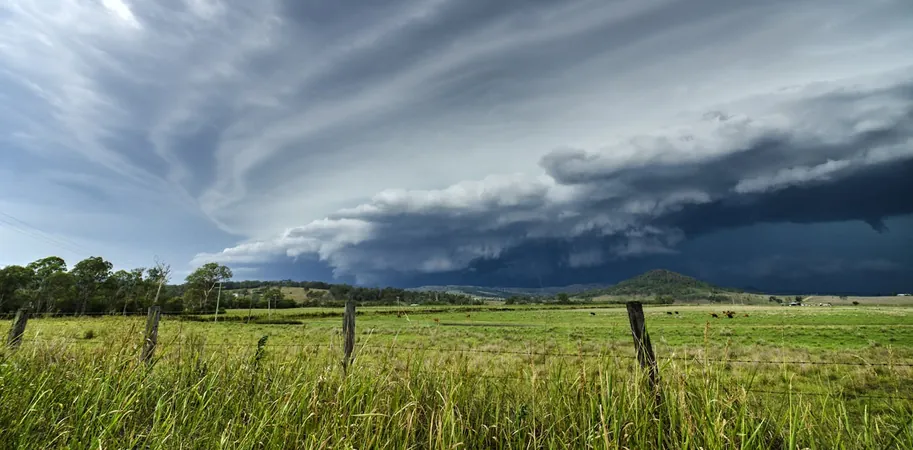
Is Thunderstorm Asthma on the Rise? Urgent Insights You Need to Know!
2024-11-20
Author: Emma
When spring rolls around, so do alarm bells about thunderstorm asthma. Surprisingly, this term wasn’t widely recognized just a decade ago. So why is it suddenly becoming part of our vocabulary, and what exactly is fueling this concern?
What is Thunderstorm Asthma? A Sudden Crisis
The first time many Australians were confronted with the harsh reality of thunderstorm asthma was during the disastrous event in November 2016 that struck Melbourne. This dramatic incident witnessed around 10,000 individuals suffering severe asthma attacks, leading to an overwhelmed health system. Emergency services were inundated with calls, and tragically, ten fatalities occurred—marking it as the most catastrophic thunderstorm asthma crisis on record globally.
In the aftermath, the Victorian Department of Health ramped up its response with initiatives, including public awareness campaigns and data-driven improvements to health services aimed at anticipating future risks. They also established a network of pollen monitoring stations across Victoria to gather real-time data for better predictive capabilities.
A History of Thunderstorm Asthma
While the 2016 event was shocking, thunderstorm asthma isn’t a new phenomenon in Australia. It was first identified in Melbourne back in 1984, just a year after it was discovered in Birmingham, UK. Since then, incidents have been reported across Australia, although Melbourne remains the epicenter for such events, with a staggering quarter of all global occurrences noted in the city.
Why Melbourne? The Perfect Storm for Thunderstorm Asthma
So, why is Melbourne particularly vulnerable? Its geographical location plays a significant role. North winds carry dry, hot air from the interior deserts of Australia, while cooler winds blow in from the ocean. This combination sets the stage for thunderstorms. Additionally, these northern winds bring in plenty of pollen, particularly grass pollen, which is a notorious trigger for both hay fever and thunderstorm asthma.
The Science Behind Grass Pollen’s Threat
Grass pollen is especially problematic during storms. Moisture in the air causes this pollen to swell, and if it absorbs too much water, it can rupture, sending tiny particles into the air. These particles are small enough to bypass the upper airway—leading to severe respiratory issues even in those without prior asthma conditions. The majority of individuals affected in the Melbourne disaster had no asthma history; instead, they had hay fever, exposing a critical oversight in understanding vulnerabilities during such events.
Are Thunderstorm Asthma Events Increasing?
Currently, thunderstorm asthma events remain rare, officially logged just 26 times worldwide. However, emerging data suggests that the frequency and severity of these events could rise, primarily attributed to climate change. Increased temperatures and pollution levels may contribute to prolonged pollen seasons and enhanced pollen production, while extreme weather events, including thunderstorms, are projected to become more frequent.
Recent statistics reveal an alarming trend in hay fever cases in Australia, with reported allergies increasing from 15% in 2008 to 24% in 2022. This pattern is mirrored in many countries, correlating with the effects of climate change.
How to Protect Yourself from Thunderstorm Asthma
As thunderstorm asthma poses an increasing risk, taking preventative measures is crucial. Here are three vital steps to safeguard your health during peak pollen seasons: 1. Stay Informed: Monitor weather forecasts for thunderstorms, especially during high pollen seasons. 2. Limit Outdoor Activity: On days when thunderstorms are expected, limit outdoor exposure, particularly during storms and the hours following one. 3. Consult Healthcare Professionals: If you have hay fever, consult your doctor for preventive medications that might help reduce your risk of severe symptoms.
In light of these developments, understanding thunderstorm asthma is more crucial than ever. Are you prepared? Stay aware, and stay safe!









 Brasil (PT)
Brasil (PT)
 Canada (EN)
Canada (EN)
 Chile (ES)
Chile (ES)
 España (ES)
España (ES)
 France (FR)
France (FR)
 Hong Kong (EN)
Hong Kong (EN)
 Italia (IT)
Italia (IT)
 日本 (JA)
日本 (JA)
 Magyarország (HU)
Magyarország (HU)
 Norge (NO)
Norge (NO)
 Polska (PL)
Polska (PL)
 Schweiz (DE)
Schweiz (DE)
 Singapore (EN)
Singapore (EN)
 Sverige (SV)
Sverige (SV)
 Suomi (FI)
Suomi (FI)
 Türkiye (TR)
Türkiye (TR)